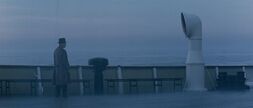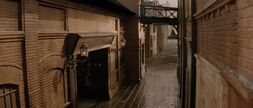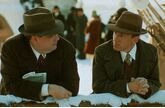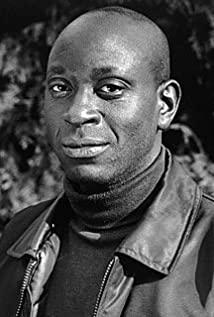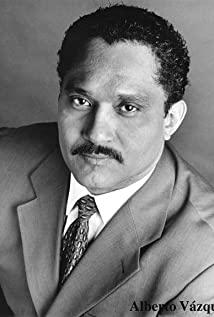Friday Yan: The expression of the film "The Pianist at Sea" is symbolic, such as the fictional utopian ship, the swaying eyes of the trumpet player, and even the fictional piano in the story. The teacher, the jazz inventor who came to challenge the pianist... And behind these symbolic people or things or things are the complex historical changes and social backgrounds (and of course the creator's emotions). So, realistically, what we get from the film's visuals and sounds is probably far less than what it's about! That requires some interpretation.
Of course, I am by no means affirming the necessity of interpreting this film, because it is enough to meet the needs of viewers at different levels just by looking and feeling. For example, a music student gets inspiration from the professional skills in the film. ; the resonance of the situation of the film narrator for a wandering office worker; the inspiration from a pianist and a trumpet player for a man who wanders between ideals and careers. This also just proves the excellence of this movie - it is entertaining and ideological, and it is also diversified and open!
Well, after clarifying the above two points, this article will take you to look at this movie from three perspectives (what is hidden behind the story, what is hidden behind the symbolic technique, and what is omitted from the "extended version"). Movies that we "don't see".
(Note: Our interpretation is based on the 165-minute extended version of "The Pianist at Sea", and the "Pianist at Sea", which is being screened in China, is 125 points)
Text: Anonymous Palace \ Edit: Mr.Friday \ Picture: Screenshot of the movie
1. What you don't see behind the story
1. The length (degree) of the time (era) spanned by the film
To know how long a movie's story spans, just pay attention to a few points in time and a few lines mentioned by the characters in the movie:
▼ The first is the time point in 1900:
This is the name of the protagonist of the film; it is also the time when the male protagonist is found on the ship (the Virginia); and of course the starting point of the whole story of The Pianist at Sea.
▼ Followed by the time point of 24 years old:
This is the time when the trumpeter (and the storyteller in the play) boarded the ship. If we assume that the trumpeter and the pianist are about the same age, and that the pianist was found not far from his birthday, we can calculate The trumpeter came aboard in the early twenties in the United States. (Note: The trumpeter was once called "Yank Yank", which means he should be an authentic American)
▲ Note that the trumpeter appears in the flashback at the beginning of the movie, indicating that it is not the beginning of the story, but the time when he boarded the ship at the age of 24
▼ Again this time in 1933:
This was when the trumpeter got off the boat, and when he was separated from the pianist at sea (since then, the two were on land and one on the water).
▲Pay attention to the tonal contrast when the trumpeter leaves the boat and the group of rich people in front of him
▼ Finally, a line from the owner of the piano shop:
"But after the war, people wanted to listen to bright music (no jazz, blues)..."
Note the words "the end of the war", it happened after the trumpeter left the ship (1933), before the Virginia ship was about to be blown up and the trumpeter boarded the ship again to find the pianist. Obviously this war refers to "World War II"! The story ends when the ship is blown up.
Based on the above, it is not difficult to infer that the story of the film "The Pianist at Sea" spanned the time from 1900 to half a century after 1945. This is absolutely epic "movie time"!
2. What happened in Europe and America during this time?
(Hint: A group photo of Einstein, a ship connecting Europe and the United States)
Note: The reason we're talking about what's happening in Europe and America, not what's happening in the world, is because the Virginia ship connects Europe and America, which is repeatedly emphasized in the movie (it carries the mostly European immigrants).
With this question in mind, let's take a look at some of the details involved in the previous time points -
The first is the childhood and adolescence of the pianist at sea, which should have been before 1900-1920 (that is, before the trumpet player came on board):
Obviously, the "First World War " broke out in Europe during this period , and the outbreak of the First World War directly led to a large number of Europeans immigrating to the United States (this is reflected in the ship, and it is not difficult to see that the refugees at that time had an impact on the United States. eager).
Then there are the years between trumpeters boarding and disembarking, this is what happened between 1920-1933:
Note that during this time, the United States promulgated the prohibition of alcohol , a large number of formal businesses in the country closed down, and speculators, gangsters, and gangs prevailed (this is reflected in another Italian film "Once Upon a Time in America");
The Great Depression in the United States broke out in the late period of Prohibition (1929-1933) (this was also the beginning of the shattering of the "American Dream");
Again , after 1933, Prohibition in the United States was gradually revoked. This is also the period after the trumpeter leaves the ship. However, the significance of this time point in 1933 is far more than that. Let’s look at a detail in the movie-
The pianist at sea is lying on the bed in the cabin bedroom. The wall beside the bed is covered with photos. The camera zooms in gradually. We see a close-up of one of the photos: it is a photo of him and Einstein (if you look closely , and a photo of the pianist with the psychologist Freud).
We put aside the possibility that the director made this shot to pay tribute to the great man, one thing is certain, these photos remind us of one thing: the outbreak of World War II (Note: Einstein left Germany for the United States probably in 1933)!
To sum up, let’s make a summary. What happened in Europe and the United States in the past half century, according to the things prompted in the movie, that is: World War I, the American Prohibition Period, the Great Depression of the American economy, World War II, and the industrial decline after World War II (this Duan is reflected in the scene outside the trumpeter).
3. Complementary experience and identity of trumpet player and pianist
If we look at the settings of the two main characters (the trumpet player and the pianist) in "The Pianist at Sea" using the above event points as a reference, you will find that the experiences of the two people play a complementary role in the actual events. . In other words, the life on land that the pianist did not experience, the trumpeter experienced! - This includes war, including social unrest, including economic decline, including the shattering of the American dream...
And the spiritual world and artistic creation that the trumpet player has not experienced, the pianist at sea has done it!
From this point of view, can we say that two characters are set up, one is a figurative character in reality, the other is an abstract character in art; one is the presentation of real life, and the other is an assumption of fantasy life...
The combination of the two people produces a strong artistic contrast and symmetry, and the symbolic plots in other parts of the film are expressed under the axis formed by these two characters.
So what is hidden in this symbolic contrast and symmetry that we do not see?
2. What you don't see behind the symbolism
1. About storytellers and storytellers
"As long as you have a good story and someone who listens to it, you're never really done for as long as you got a good story and someone to tell it to!"
This sentence comes from the mouth of the pianist at sea, but it is repeated no less than three times by the trumpet player. Not only that, when the trumpeter tells the story, the film repeatedly shows signs that those who listen to the story are deeply attracted (in the flashbacks and the listener's response).
This is enough to prove that the director attaches great importance to storytelling (film) techniques and skills! It is also enough to reflect the way Italian directors make good use of stories! (The Hong Kong-produced film "Thirteen Brothers of the South China Sea", which was released in the same year, has the same storytelling technique.) Throughout the trilogy of Italian director Tonadore ("Paradise Cinema", "The Pianist at Sea", "The Beauty of Sicily") Legends”) are all used in this way of storytelling.
2. Three F*ck...
The main characters in "The Pianist at Sea" are generally quite gentlemen, all of them are well-mannered and good-natured. Therefore, the few "F*ck" that appear in the film are particularly conspicuous. In fact, it is accurate to say formal No more, no less, from the mouth, only three times:
▼ The first time was the father of the pianist to the captain: F*ck the law (law)
▼ The second time is the young pianist to the captain: F*ck the regulations (rules)
▼ For the third time, the pianist challenged the musicians: F*ck jazz (jazz)
I think these three F*ck lines are not random lines, he is a symbolic line carefully designed by the director, which reflects the creator's attitude towards politics, secularism and the cultural values of the capitalist country, and also A layer of highly democratic, utopian romance was born for the Virginia ship.
These three sentences form the creator's personal emotional framework for the entire film.
3. Bombed ships, pianists, and lost jazz
Of course, it is this layer of romance that makes the ship appear more illusory, surreal, and unpermanent. This is also the symbolic meaning of the eventual bombing of the Virginia.
Note: Two other things were destroyed at the same time as the ship - the pianist and the "jazz"
It is not difficult to understand that a pianist at sea is destroyed along with the ship. His personality itself is unrealistic and cannot survive in reality. From a practical point of view, it is not right for a person like him to survive in a "civilized society". !
Let's look at "jazz". The creator's emotions are on full display in the scene outside the trumpeter's boat. At the beginning of the movie, a tragic color was played - he (the trumpet player) was in a dilemma and wanted to sell his favorite and most precious Conn trumpet, which in the eyes of the businessman was only worth six British pounds (twenty-five dollars). These numbers and plots are enough to symbolize the creator's sadness about the decline of "traditional jazz".
▼ In reality, the development of jazz has experienced two changes:
One was the migration from New Orleans in the south of the United States to the north in the 1920s and 1930s. This shift made traditional jazz more popular, but also more commercialized. Commercially packaged jazz stars came into being in this period, and the jazz player who came from New York to PK the pianist at sea in the movie is a symbolic representative of this transformation process;
Another change was the fusion and rock-and-roll transformation of jazz after World War II, which is also a testament to jazz's further approach to commercialization. (Elvis Presley and The Beatles were born during this period)
From this point of view, the director ties the personal emotions of the decline of jazz with the decline of the times and society, and his symbolic techniques are extremely clever.
4. The pianist disembarks, throws his hat, and returns to the boat
Many people who have watched "The Pianist at Sea" are always wondering why the pianist didn't get off the ship. Not to mention that there is a woman who loves at first sight waiting for him...
This kind of thinking is typical of the thinking mode of commercial films that are divorced from reality. Many people may attribute the reason for not getting off the boat to the pianist father and the influence of the Italian's words on him, but this is based on a particularity and artistic contingency!
If we take the pianist at sea as a symbol of a type of people and understand the concept that such people cannot survive in reality, it is not difficult to understand the choice of the pianist (this was mentioned earlier).
So what is the reality (or what is the land like), let's look at the critical point in the film where the pianist gets off the boat and stays on the boat——
Note: The visual counterpart of the bird in the air and the hat thrown by the pianist is extremely symbolic.
Of course, people with different meanings have different understandings. My subjective feeling is—
The tall buildings and smoky birds symbolize the unknown fate of those who work hard in the city, and the hat symbolizes the so-called "civilization" of capitalist society. The pianist threw his hat, also showing his fear and resistance to this possible life on land. Turning back to the ship showed his farewell to this "civilized society".
5. Eyes swaying and boat swaying
If you can compare the romantic "shaking" of the ship with the "shaking" of the trumpeter's eyeballs in reality, it is not difficult to appreciate the symbolic color.
Naturally, for a trumpeter, a person who wanders on land and sea, his life must also be wandering, wandering left and right, and he is also wandering between sensibility and reason...
As the pianist said on his deathbed: there is no limit to the music you can create on the keys... and you can't play at all on this infinite keyboard (overboard), you're sitting at the wrong piano...
3. "Abridged Version" You Haven't Seen
1. A close-up of the opening trumpet
The 125-minute abridged version begins with an overhead shot of the trumpeter sitting on the stairs, and the voiceover of the trumpeter begins to tell. The extended version added a close-up shot of a trumpet speaker before this scene, and the lens was pulled back slightly, overlapping to cause the stairs to be shot overhead.
I think the addition of this shot underscores the concept of a story's "subjective narrative", prompting us to focus not only on the story, but also on the storyteller! That's why the film is so personal.
2. F*ck the law
We mentioned "Three F*cks" before, but the 125-minute version is missing the first "F*ck the law" scene before and after - this scene is roughly about childhood pranks in 1900, going to With cake splashed on the captain's face, the captain angrily went to the cabin to complain to his father, and then his father said the F*ck words...
This scene shows the pianist's childhood upbringing, educational environment, and the character of everyone around him, and also adds a utopian "big family vibe" to the ship, so I think it's very important to the whole movie. help understanding is indispensable. 3. Chorus in the Creation Cabin
After old Danny picked up the baby and took it to the underground cabin to name it, everyone sang "Thanks Danny". Of course, this is a paragraph in an extended version.
This short one-minute "collective chorus" brought about the kind of appeal of the unity of the working people at the bottom. You know, it is this bottom level and this working environment that gave birth to the musical genius of a pianist at sea. This play echoes and symbolically interprets the subsequent play performed by the pianist for the third-class working class on the ship.
Another big contrast on the ship formed by the whole movie is: the singing and dancing of the luxury cabin and the messy and noisy third-class cabin and the bottom cabin...
4. The third-class cabin plays the gods
When the pianist played in the third-class cabin, the camera gradually drew closer to the pianist. Then, the camera followed the drifting notes and turned to the sea outside the cabin. This scene is like an MV, which is intoxicating. Unfortunately, the audience of the 125 version I couldn't enjoy it, and the whole paragraph was cut off.
5. An ensemble of Italians and sea pianists
Similar to this scene, there is also the ensemble of the Italian (that is, the father of the woman who fell in love with the pianist at first sight) and the pianist. It appeared before the Italian chatted with the pianist. In Italian words: that is An involuntary performance.
As for the beauty of this piece of music and the beauty of the footage, I can't express it in words, but unfortunately, the audience of the abridged version still can't enjoy it.
6. Ending "The Woman Who Comes Onward"
At the end of the Homely 165 version, when the trumpeter walked out of the piano shop, a woman in the depths of the street came across the street. She seemed to be wearing a sailor suit. The two walked towards each other and gradually approached... However, the woman turned in another aisle and disappeared into the camera, Only the back of the trumpeter remains;
And version 125, at the end, the street is empty when the trumpeter walks out the door.
Obviously, the oncoming woman in the extended version was not a random stroke. The 125 version removed that person, which is incredible.
7. Other
When the trumpeter tells the story, the scenes before and after the flashback are deleted a lot, and their impact on the rhythm and the audience's gasping cannot be ignored.
4. My "Sea Pianist" Plot
The first time I watched "The Pianist at Sea" was around the beginning of 2000. I clearly remember the focus of my attention at that time - naturally, it was on the pianist's pleasing piano plays, and most of the other scenes, probably with Time is forgotten.
A few years later, I watched this film for the second time after work. In addition to the pleasant music, I found that I had a little more resonance with the pianist's loneliness, and this loneliness will make you more and more. Isolation from the mainstream is like what the pianist said to the trumpet player before blowing up the ship: you are a minority …
Watching this movie again today, I just realized that it was not only the pianist who attracted me, but also the trumpet player (the feeling of wandering left and right is indescribable) - if there is no complementary experience between the two , There is no comparison of the structure of the two characters, and there is no storyteller and storyteller, where can the moving and feeling of those watching the movie come from.
However, the question that bothers me still remains: Is there not a middle ground between the sea and the land, in other words, between the ideal and the reality, people like the "sea pianist" really can't survive ?
Too bad the movie doesn't give an answer!
But one thing we can be sure of, neither of the two people in the movie is the answer we want to look for, and their respective paths are not so optimistic. They seem to be restrained by something about the fate of the times, showing a tragic color.
And this kind of tragic color can only be produced in the art of film, and in real life, who would dare to pursue it!
Interpretation of classic movies, pay attention to [Friday Literature and Art]
View more about The Legend of 1900 reviews



